Papers by Michael Conover
Human–Wildlife Interactions, 2008
Human–Wildlife Interactions, 2015
Human–Wildlife Interactions, 2017
Human–Wildlife Interactions, 2008
Journal of Oceanology and Limnology
Predator-Prey Dynamics, 2007
The Wilson Journal of Ornithology, 1984
Dans le cas de perte du partenaire, la femelle de certains larides peut former un couple femelle-... more Dans le cas de perte du partenaire, la femelle de certains larides peut former un couple femelle-femelle ou recruter un mâle pour former un couple heterosexuel. Il ne semble pas en etre ainsi chez Larus delawarensis ou L. californicus mais on ne peut exclure cette possibilite
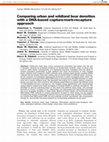
Human–Wildlife Interactions, 2017
California’s black bear (Ursus americanus) population has tripled over the last 3 decades, causin... more California’s black bear (Ursus americanus) population has tripled over the last 3 decades, causing an increased incidence of human–bear confl icts, many of which now occur in urban areas. Consequently, it is imperative that bear managers have the ability to monitor population parameters in both wildland and urban environments to help manage bears. Capture-mark-recapture (CMR) methods using uniquely typed genetic samples (DNA) collected via hair-snares have been widely used to monitor bears in wildland areas. However, we are unaware of researchers applying this technique to bears occupying urban areas. We implemented a multi-year DNA-based CMR study to compare bear densities between an urban area and a nearby wildland area. We deployed hair-snares for 6 weekly capture occasions during June and July, 2011 and 2012. We uniquely typed DNA from snared hair follicles using 14 microsatellite loci and 2 sexing loci. We coupled unique identifi cation with robust-design closed-capture models ...
Predator-Prey Dynamics, 2007
Journal of Wildlife Management, Sep 21, 2016
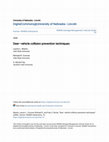
DOAJ (DOAJ: Directory of Open Access Journals), Feb 1, 2017
Every year in the United States approximately 1.5 million deer-vehicle collisions (DVCs) occur re... more Every year in the United States approximately 1.5 million deer-vehicle collisions (DVCs) occur resulting in >29,000 human injuries, >200 human fatalities, 1.3 million deer fatalities, and >1 billion dollars worth of property damage. Despite the magnitude of this problem, there are relatively few well-designed studies that have evaluated techniques that can be used to reduce DVCs. Techniques to reduce DVCs fall into 4 categories: reducing the number of deer (Odocoileus spp.), reducing the number of vehicles, modifying deer behavior, and changing motorist behavior. Techniques to reduce the number of deer include decreasing the deer population or excluding deer from the roadway. Techniques used to change motorist behavior include reducing vehicle speed or increasing motorists' ability to see deer. Modifying deer behavior includes making the roadside less attractive to deer or frightening deer away from the roadway. Despite a limited amount of data, multiple studies have shown properly installed and maintained fences combined with wildlife crossings to be the most effective method of reducing DVCs. Methods with unproven effectiveness include: intercept feeding, repellents, reduced speed limits, caution signs, and roadway lighting. Stimuli designed to frighten deer (e.g., deer whistles, fl agging, and deer refl ectors) are ineffective because they cannot be perceived by deer or do not elicit a fl ight response. Well-designed studies are needed so that we can acquire the knowledge about how to reduce the frequency of DVCs.

Waterbirds, Mar 1, 2016
Shelterbelts are long rows of trees planted in the Great Plains of North America to reduce wind e... more Shelterbelts are long rows of trees planted in the Great Plains of North America to reduce wind erosion of soil. Shelterbelts alter airflow, creating updrafts on the windward side (updraft zone), slow winds immediately on the leeward side (calm zone), and increased turbulence farther downwind of the shelterbelt (turbulent zone). They also provide hunting perches for avian predators and serve as corridors for mammalian predators. By determining the fate of 247 duck nests located in 27 Waterfowl Production Areas during 2006 and 2007, this study tested the hypothesis that duck nests located close to shelterbelts are more likely to be depredated than nests located in open fields and that nest densities are lower near shelterbelts than in open fields. Nest density in a shelterbelt's calm zone (0.22 nests/ha) was lower than in open fields (1.02 nest/ha). Shelterbelt orientation and porosity to airflow did not affect nest success or nest density. Shelterbelt height did not influence nest density, but nest success decreased as shelterbelts increased in height. Depredation rates were higher for nests near isolated structures (e.g., isolated trees, snags, and utility poles) than for nests near shelterbelts or in open fields.

The Wilson Journal of Ornithology, 1984
In recent years, female-female pairings have been discovered in Western Gulls (Larus occidentalis... more In recent years, female-female pairings have been discovered in Western Gulls (Larus occidentalis) (Hunt and Hunt 1977), Ring-billed Gulls (L. delawurensis) (Conover et al. 1979, Ryder and Somppi 1979), California Gulls (L. culijbrnicus) (Conover et al. 1979), and Herring Gulls (L. argentatus) (Fitch 1979). These associations occur when two females pair together rather than with male mates and both lay eggs in a mutual nest. It has yet to be determined whether female pairs are restricted to a small number of gull species or are widespread among the normally monogamous Laridae. Supporting the latter possibility is the recent discovery of female pairs among breeding Caspian Terns (Sterna cuspia) (Conover 1983). Such female pairs are often identifiable because their nests contain supernormal clutches (4-6 eggs), double the normal clutch-size. Not all supernormal clutches (SNCs), however, result from female pairings. In a study of Ring-billed Gulls, 17% of the 5-6 egg clutches resulted from polygynous associations in which two or more females lay eggs in the same nest (Conover, in press). Furthermore, a polygynous group was found attending a SNC in the Brown Skua (Catharucta skua) (Bonner 1964). Hence, the presence of SNCs in a particular species may indicate that either female pairings or polygynous associations occur in that species. This is not necessarily the case, however, for a few SNCs may also result from adults rolling a foreign egg into their nest or from nest parasitism although normally neither event should cause a doubling of clutch-size, except for one-egg clutches. In this study, I used clutch-size data to estimate the frequency of SNCs in different gull and tern species. Such information is useful in identifying those species in which female pairings or polygyny may occur. These data were also used to test the hypothesis that DDT contamination produces female pairings by feminizing male embryos (Fry and Toone 198 1). If this is so, the frequency of female pairs and consequently SNCs should have increased since the late 1940s when DDT' s widespread usage began. METHODS Dejinition of supernormalclutch.-Supernormal clutch, an imprecise term, has historically signified an unusually large clutch. This term has been applied mostly to birds which usually lay three-egg clutches; for these birds, most authors agree that clutches containing five or more eggs are supernormal but disagree on the inclusion of four-egg clutches. Hunt and 249 252
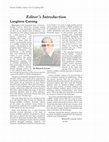
Human–Wildlife Interactions, 2007
Welcome to this inaugural issue of Human-Wildlife Confl icts. Much has changed during my lifetime... more Welcome to this inaugural issue of Human-Wildlife Confl icts. Much has changed during my lifetime. I can remember when there were no deer on my family's farm in Illinois. I can remember in 1979 seeing Canada geese feeding in a golf course in New Haven, Connecticut, and thinking they were a lost family of geese from the Arctic. I can remember going to a wildlife conference and seeing a presentation in the program, titled "Turkey problems in Wisconsin," and wondering if the turkeys they were referring to had wings or wore overalls. I can remember the editor of The Journal of Wildlife Management refusing even to consider publishing my fi rst manuscript on humanwildlife confl icts because animal damage control (as it was called in those days) was outside the purview of the journal and not a part of the fi eld of wildlife management. Things have defi nitely changed in the last few decades. Today, you cannot grow soybeans on my family's farm because deer eat all the plants. Now, geese are so numerous in New Haven that the locals call them "those #$@%### geese." Today, we have urban geese, urban foxes, urban coyotes, urban deer, urban elk, and you heard it here fi rst-urban buff alo (see page 3). We have zoonotics diseases, such as avian infl uenza, West Nile disease, and Lyme disease that were unknown a few decades ago.

Waterbirds, Jun 1, 2015
Abstract Nest depredation is the leading cause of waterfowl nest failures in much of the Prairie ... more Abstract Nest depredation is the leading cause of waterfowl nest failures in much of the Prairie Pothole Region, USA. In 2006 and 2007, spatial and temporal patterns of nest depredation were evaluated on 248 waterfowl nests and 88 simulated waterfowl nests in North Dakota, USA. The hypothesis that predators are able to locate adjacent nests using an area-restricted search once they find the first nest and that ducks will space their nests apart to reduce this from happening was tested. However, no evidence was found to support either part of this hypothesis or that density-dependent depredation was occurring. This lack of support, along with no relationship between nest density and nest success, indicate that density-dependent depredation may not have been a problem in our study area. Artificial nests were used to test the hypothesis that meteorological conditions impact nest depredation rates. Artificial nests were more likely to be depredated when either temperature or dew point was high. It was hypothesized that these meteorological conditions increase the evaporation rate of odorants, and thereby improve the ability of predators to locate food sources by using olfaction. These meteorological conditions could also increase odor release from the surfaces of nests or incubating hens, although additional studies are necessary to determine if the relationship between evaporation rates and foraging efficiency of olfactory predators holds for natural waterfowl nests.
Human–Wildlife Interactions, 2010
This issue marks the fourth year of publication of our journal, and with this notable achievement... more This issue marks the fourth year of publication of our journal, and with this notable achievement, we are pleased to announce 3 changes that refl ect the journal's growing stature. First, the Jack Berryman Institute has changed the journal's name from Human-Wildlife Confl icts to Human-Wildlife Interactions to bett er refl ect the journal's expanded mission of publishing papers dealing with the management of wildlife. Despite the name change, the journal will continue its mission of providing a worldwide forum for articles on human-wildlife confl icts. The new name merely refl ects our desire to place these articles in the broader context of applied wildlife management. The second change is that we have created an editorial board for Human-Wildlife Interactions.
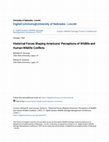
From colonial times until the 19th century, the dominant American view of wildlife and its manage... more From colonial times until the 19th century, the dominant American view of wildlife and its management was dualistic—wildlife species were divided into good animals (those which had commercial value or could be eaten) or bad animals (those which threatened the colonists’ safety or food supply). Philosophically, early colonial Americans believed that the environment was to be manipulated for man’s purposes. Under the impact of modernization, Darwinian influence, over-exploitation of resources, and environmentally-conscious professionals, Americans in the late 19th century began to appreciate the recreational value of wildlife and to develop a more protective attitude toward it. Still the dichotomy between good and bad wildlife prevailed, with “good” species now being those that could be hunted. The world wars and the Great Depression halted the tilt toward a more protective approach to wildlife as Americans became more concerned with economic matters and agricultural productivity. Onl...




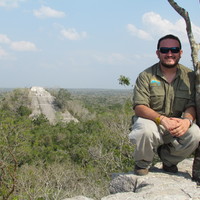





Uploads
Papers by Michael Conover